brakes GMC SIERRA 1995 Owners Manual
[x] Cancel search | Manufacturer: GMC, Model Year: 1995, Model line: SIERRA, Model: GMC SIERRA 1995Pages: 488, PDF Size: 26.01 MB
Page 82 of 488
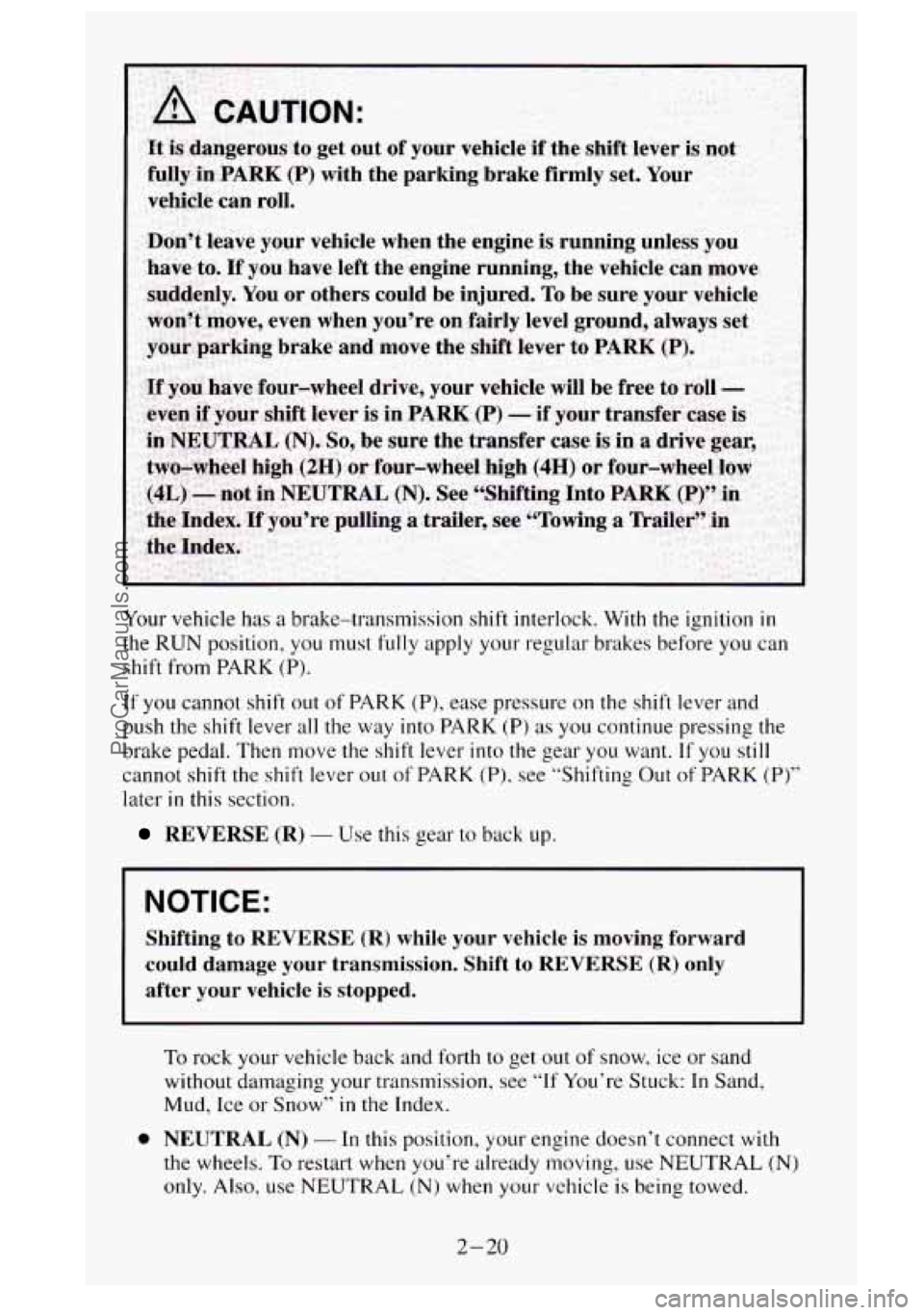
Your vehicle has a brake-transmission shift interlock. With the ignition in
the RUN position, you must fully apply your regular brakes before you can
shift from PARK (P).
If you cannot shift out of PARK (P), ease pressure on the shift lever and
push the
shift lever all the way into PARK (P) as you continue pressing the
brake pedal.
Then move the shift lever into the gear you want. If you still
cannot shift the shift lever out of
PARK (P), see ”Shifting Out of PARK (P)”
later in this section.
REVERSE (R) - Use this gear to back up.
NOTICE:
Shifting to REVERSE (R) while your vehicle is moving forward
could damage your transmission. Shift to REVERSE
(R) only
after your vehicle is stopped.
To rock your vehicle back and forth to get out of snow, ice or sand
without damaging your transmission, see
“If You‘re Stuck: In Sand,
Mud, Ice or Snow”
in the Index.
a NEUTRAL (N) - In this position, your engine doesn’t connect with
the wheels. To restart when you’re already moving, use NEUTRAL (N)
only. Also, use NEUTRAL (N) when your vehicle is being towed.
2-20
ProCarManuals.com
Page 83 of 488

A CAUTION:
Shifting out of PARK (f) or NEUTRAL (N) while your engine is
“racing” (running at high speed) is dangerous. Unless your foot
is firmly on the brake pedal, your vehicle could move very
rapidly.
You could lose control and hit people or objects. Don’t
shift out of
PARK (P) or NEUTRAL (N) while your engine is
racing.
NOTICE:
Damage to your transmission caused by shifting out of PARK
(P) or NEUTRAL (N) with the engine racing isn’t covered by
your warranty.
AUTOMATIC OVERDRIVE (a) - This position is for normal
driving. If you need more power for passing, and you’re:
- Going less than about 35 mph (56 km/h), push your accelerator
pedal about halfway down.
the way down.
You’ll shift down to the next gear and have more power.
- Going about 35 mph (56 kdh) or more, push the accelerator all
0 should not be used when towing a trailer, carrying a heavy load,
driving on steep hills, or for off-road driving. Select THIRD
GEAR
(3) when operating the vehicle under any of these
conditions.
THIRD GEAR (3) - This is like 63, but you never go into Overdrive.
You should use
THIRD GEAR (3) when towing a trailer. carrying a
heavy load, driving on steep hills, or
for off-road driving.
0 SECOND GEAR (2) - This position gives you more power but lower
fuel economy. You can use
SECOND GEAR (2) on hills. It can help
control
your speed as you go down steep mountain roads, but then you
would also want
to use your brakes off and on.
If you manually select SECOND GEAR (2), the transmission will drive
in second gear. You may use this feature for reducing torque to the rear
wheels when you are trying
to start your vehicle from a stop on
slippery road surfaces.
2-21
ProCarManuals.com
Page 84 of 488
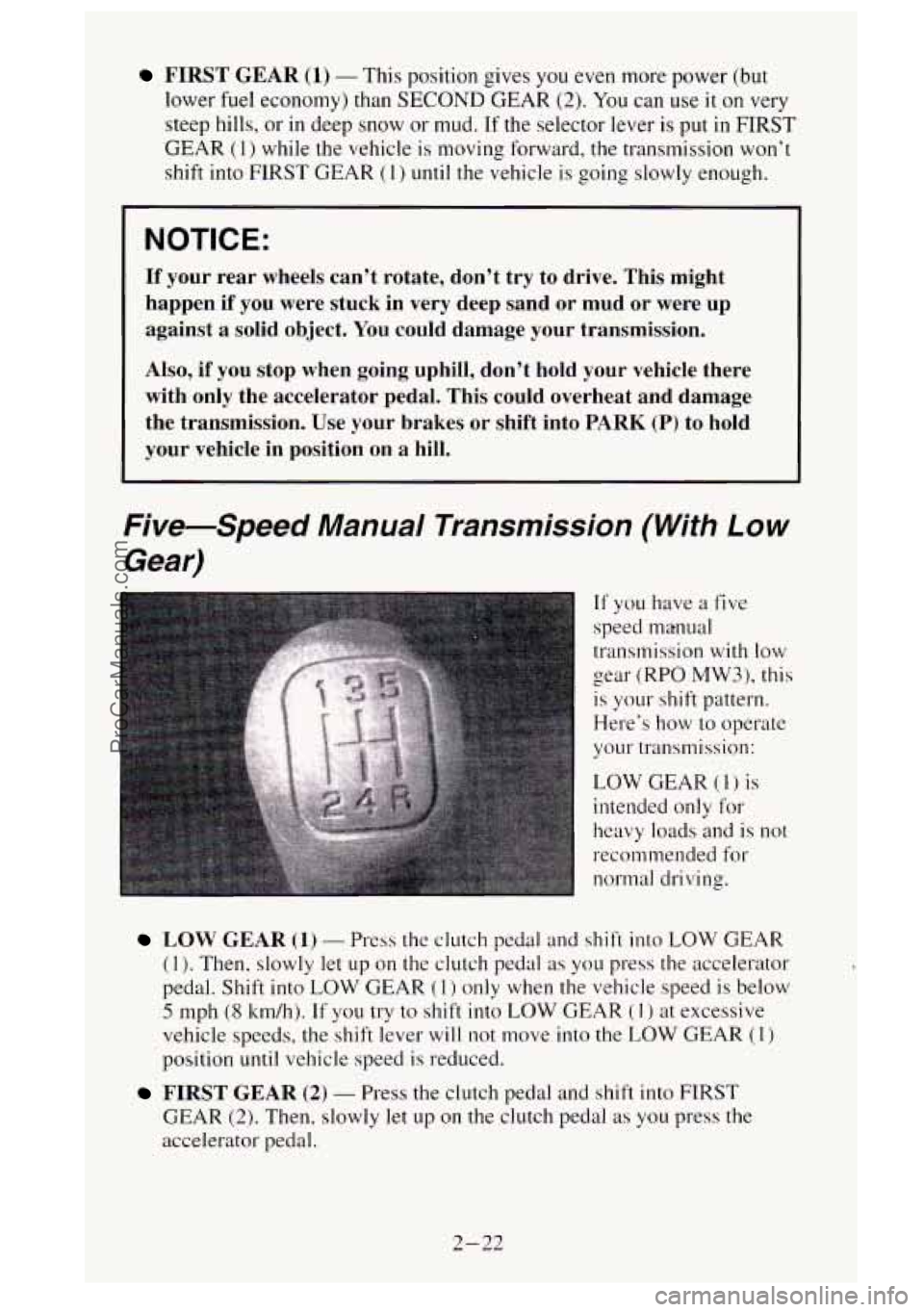
FIRST GEAR (1) - This position gives you even more power (but
lower
fuel economy) than SECOND GEAR (2). You can use it on very
steep hills, or in deep snow or mud. If the selector lever is put in FIRST
GEAR (1) while the vehicle is moving forward, the transmission won’t
shift into FIRST GEAR
(1) until the vehicle is going slowly enough.
NOTICE:
If your rear wheels can’t rotate, don’t try to drive. This might
happen if you were stuck in very deep sand
or mud or were up
against a solid object.
You could damage your transmission.
Also, if you stop when going uphill, don’t hold your vehicle there
with only the accelerator pedal. This could overheat and damage
the transmission.
Use your brakes or shift into PARK (P) to hold
your vehicle in position on a hill.
Five-Spa-ld Manual Transmission (With Low
Gear)
If you have a five
speed manual
transmission with
low
gear (RPO MW3), this
is your shift pattern.
Here’s how to operate
your transmission:
LOW GEAR (1) is
intended only for
heavy loads and is
not
recommended for
normal driving.
LOW GEAR (1) - Press the clutch pedal and shift into LOW GEAR
(1). Then, slowly let up on the clutch pedal as you press the accelerator
pedal. Shift into
LOW GEAR (1) only when the vehicle speed is below
5 mph (8 km/h). If you try to shift into LOW GEAR (I ) at excessive
vehicle speeds, the shift lever
will not move into the LOW GEAR (1)
position until vehicle speed is reduced.
FIRST GEAR (2) - Press the clutch pedal and shift into FIRST
GEAR (2). Then, slowly let up on the clutch pedal as you press the
accelerator pedal.
2-22
ProCarManuals.com
Page 90 of 488
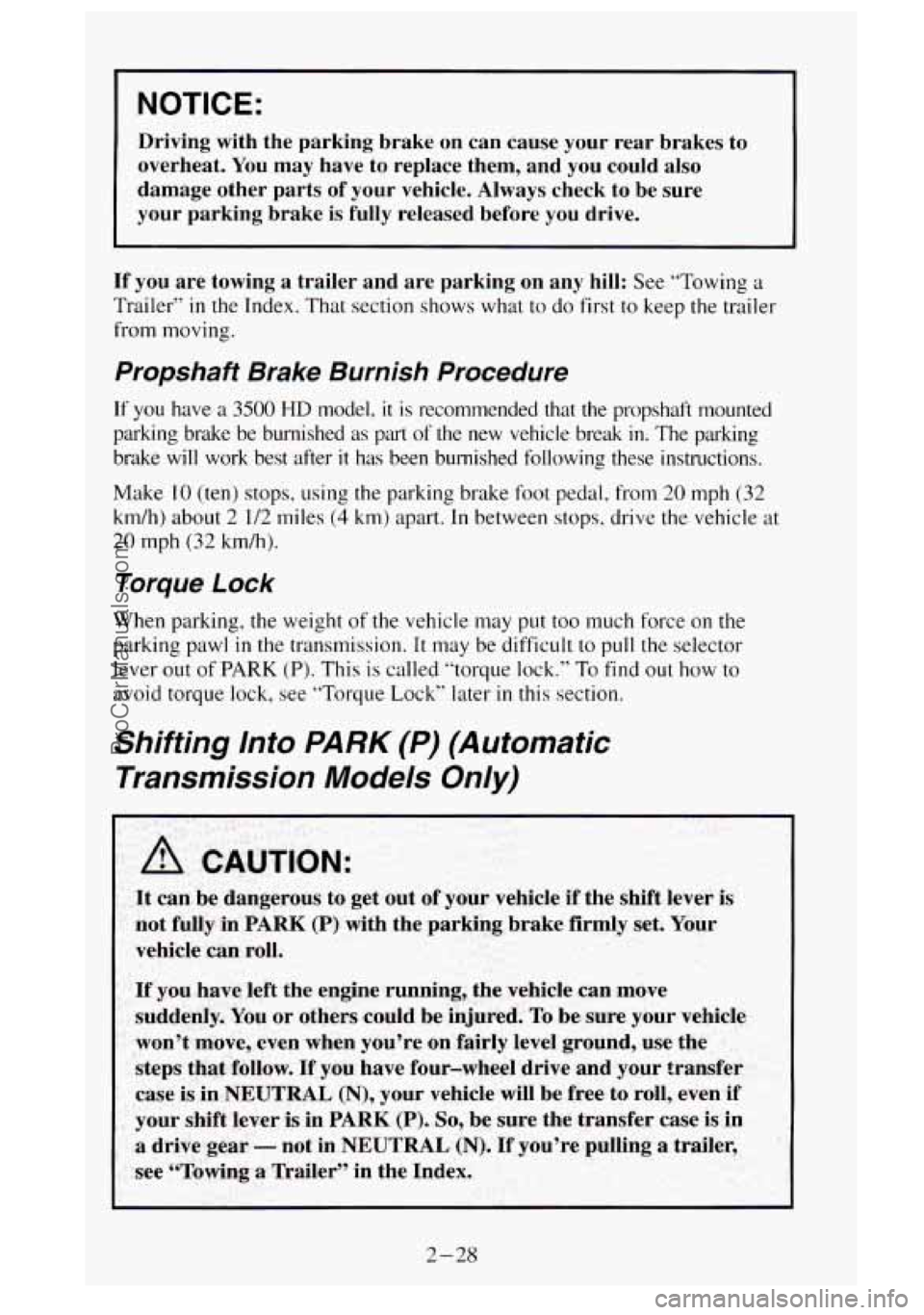
NOTICE:
Driving with the parking brake on can cause your rear brakes to
overheat. You may have to replace them, and you could also
damage other parts of your vehicle. Always check to be sure
your parking brake is fully released before you drive.
If you are towing a trailer and are parking on any hill: See “Towing a
Trailer” in the Index. That section shows what to do first to keep the trailer
from moving.
Propshaft Brake Burnish Procedure
If you have a 3500 HD model, it is recommended that the propshaft mounted
parking brake be burnished
as part of the new vehicle break in. The parking
brake will work best after
it has been burnished following these instructions.
Make
10 (ten) stops, using the parking brake foot pedal, from 20 mph (32
km/h) about
2 1/2 miles (4 km) apart. In between stops, drive the vehicle at
20 mph (32 km/h).
Torque Lock
When parking, the weight of the vehicle may put too much force on the
parking pawl
in the transmission. It may be difficult to pull the selector
lever out of
PARK (P). This is called ”torque lock.” To find out how to
avoid torque lock, see “Torque Lock” later in this section.
Shifting lnto PARK (P) (Automatic
Transmission Models Only)
2-28
ProCarManuals.com
Page 91 of 488
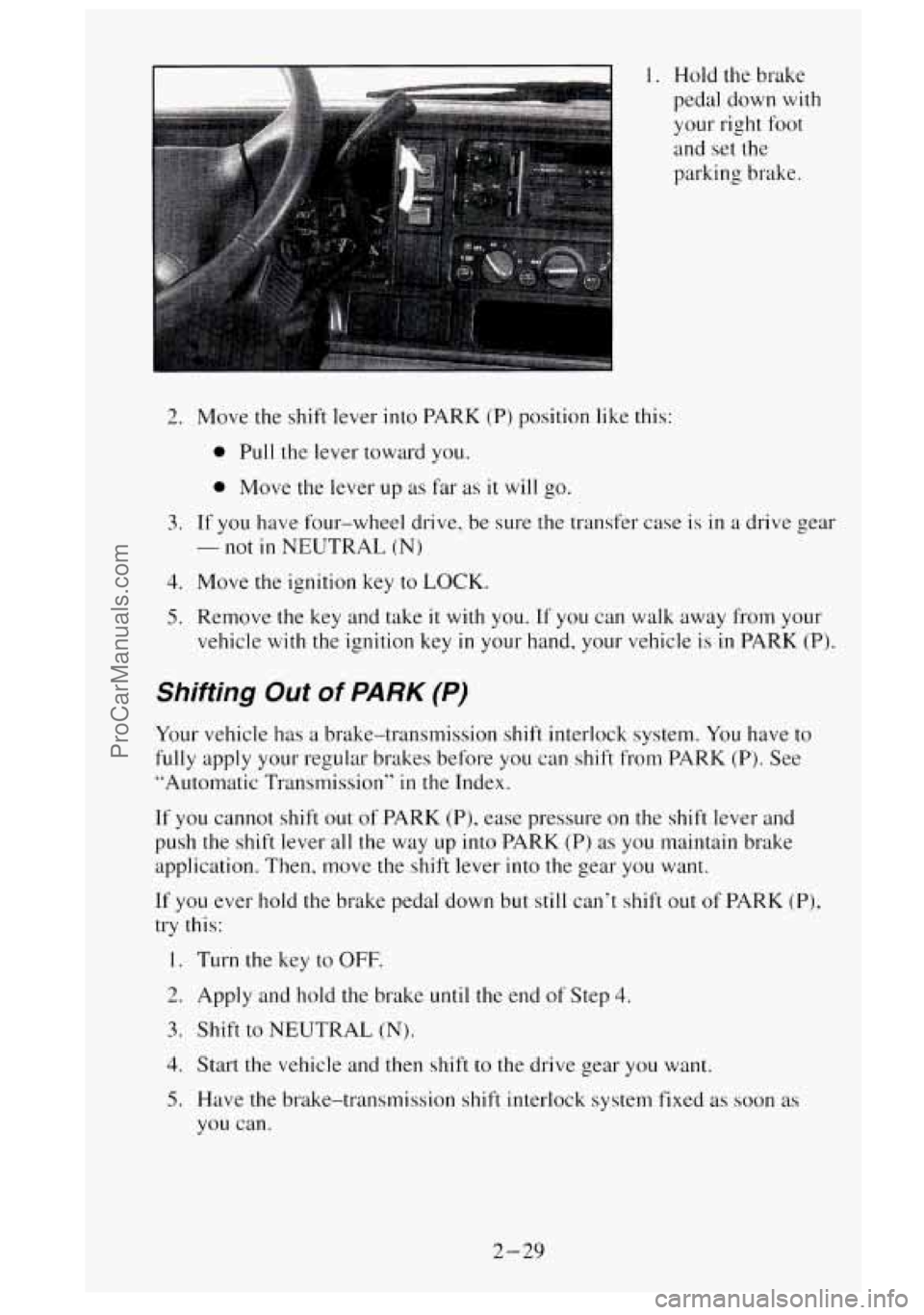
I. Hold the brake
pedal down
with
your right foot
and set the
parking brake.
2. Move the shift lever into PARK (P) position like this:
0 Pull the lever toward you.
0 Move the lever up as far as it will go.
3. If you have four-wheel drive, be sure the transfer case is in a drive gear
- not in NEUTRAL (N)
4. Move the ignition key to LOCK.
5. Remove the key and take it with you. If you can walk away from your
vehicle
with the ignition key in your hand, your vehicle is in PARK (P).
Shifting Out of PARK (P)
Your vehicle has a brake-transmission shift interlock system. You have to
fully apply your regular brakes before you can shift from PARK (P). See
“Automatic Transmission”
in the Index.
If you cannot shift out of PARK (P), ease pressure on the shift lever and
push the shift lever all the way up into PARK (P) as you maintain brake
application. Then, move the shift lever into the gear you want.
If you ever hold the brake pedal down but still can’t shift out of PARK (P),
try this:
1. Turn the key to OFF.
2. Apply and hold the brake until the end of Step 4.
3. Shift to NEUTRAL (N).
3. Start the vehicle and then shift to the drive gear you want.
5. Have the brake-transmission shift interlock system fixed as soon as
you can.
2-29
ProCarManuals.com
Page 105 of 488
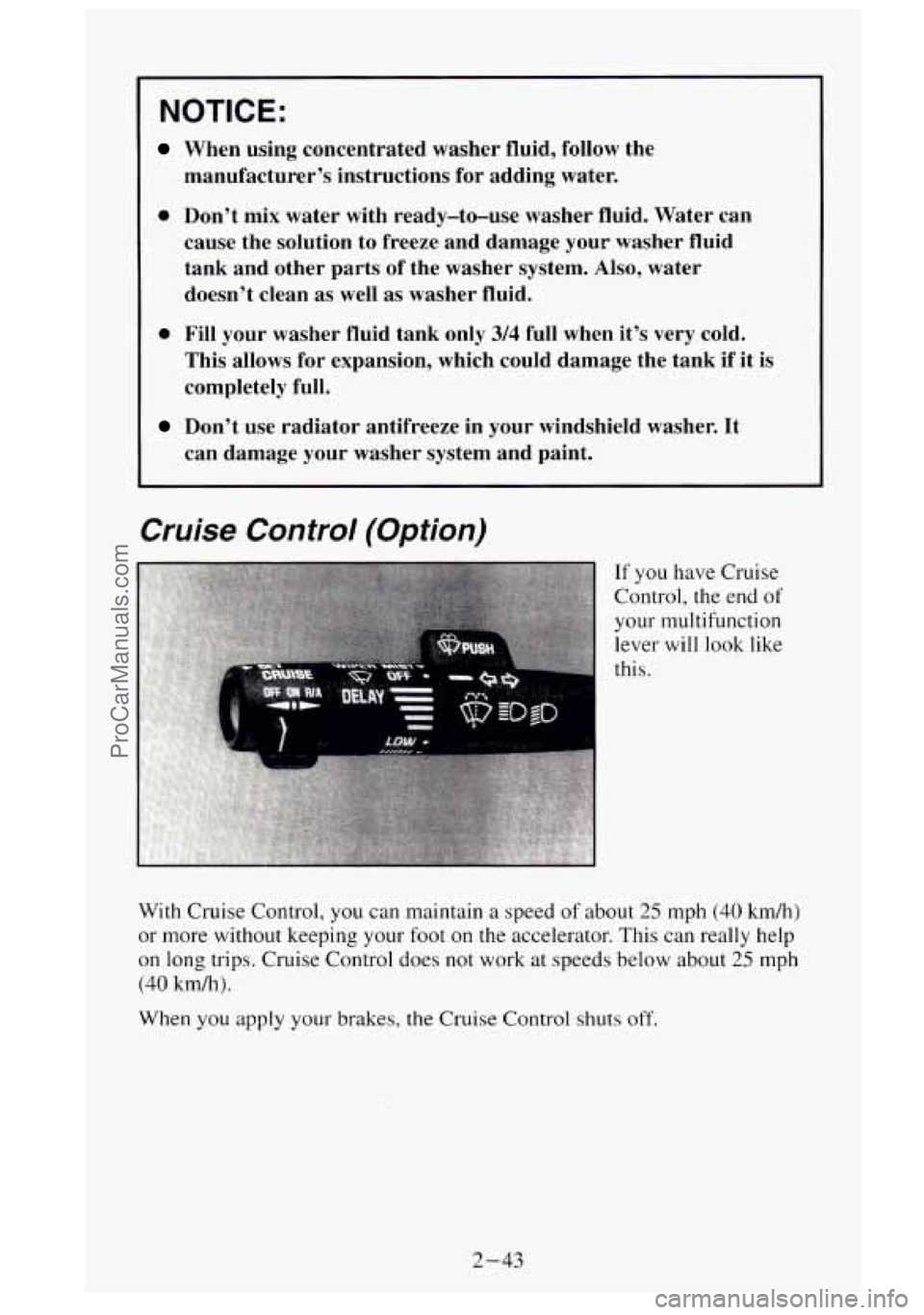
NOTICE:
When using concentrated washer fluid, follow the
manufacturer’s instructions for adding water.
0 Don’t mix water with ready-to-use washer fluid. Water can cause the solution to freeze and damage your washer fluid
tank and other parts of the washer system.
Also, water
doesn’t clean as well as washer fluid.
0 Fill your washer fluid tank only 3/4 full when it’s very cold.
This allows for expansion, which could damage the tank if it is
completely full.
Don’t use radiator antifreeze in your windshield washer. It
can damage your washer system and paint.
Cruise Control (Option)
If you have Cruise
Control, the end
of
your multifunction
lever
will look like
this.
With Cruise Control,
you can maintain a speed of about 25 mph (40 kdh)
or more without keeping your foot on the accelerator. This can really help
on
long trips. Cruise Control does not work at speeds below about 25 mph
(40 kmk).
When you apply your brakes, the Cruise Control shuts off.
2-43
ProCarManuals.com
Page 135 of 488
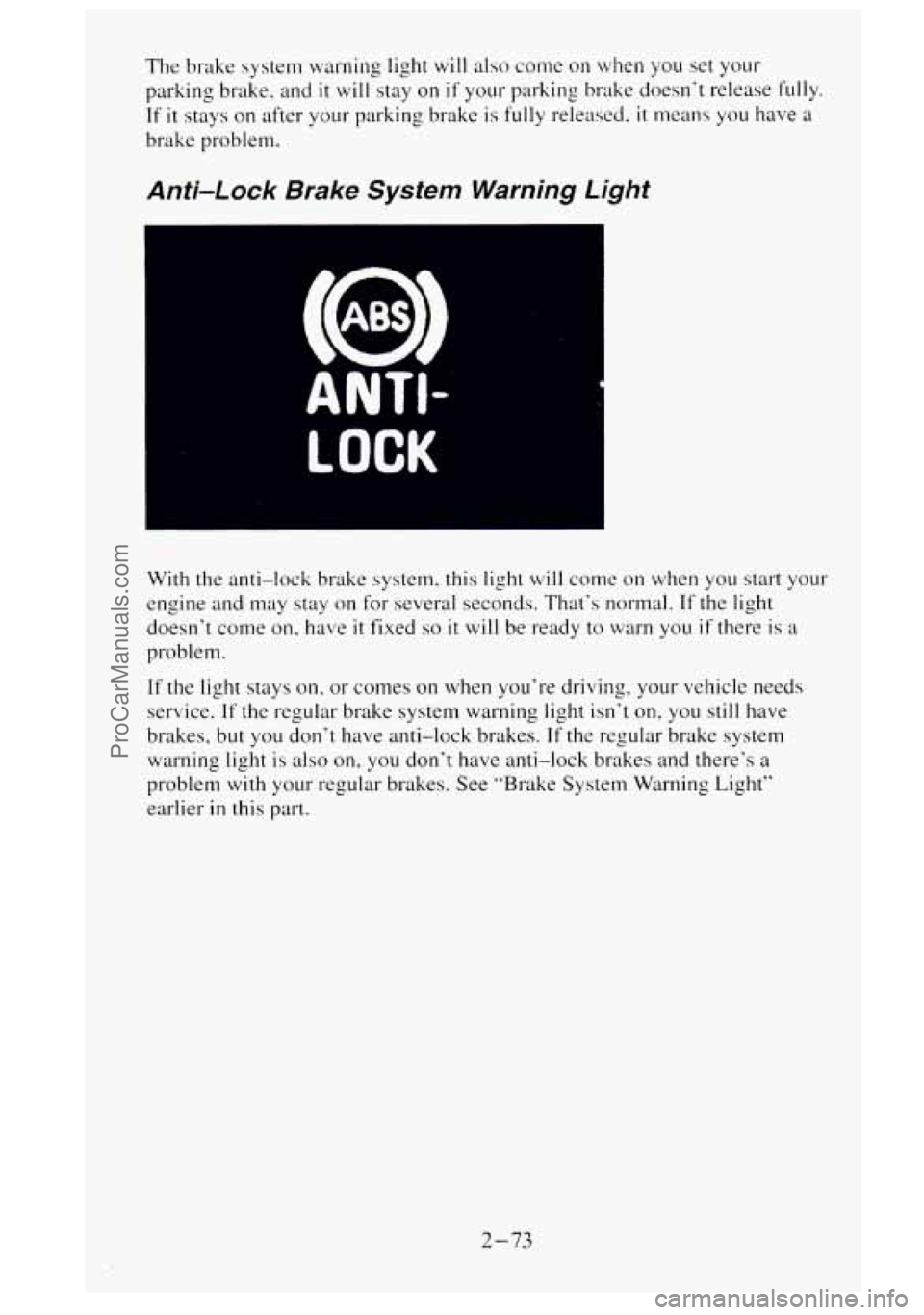
The brake system warning light will also come on when you set your
parking brake, and
it will stay on if your parking brake doesn’t release fully.
If it stays on after your parking brake is fully released, it means you have a
brake problem.
Anti-Lock Brake System Warning Light
ANTI-
LOCK
With the anti-lock brake system, this light will come on when you start your
engine and may stay on for several seconds. That‘s normal.
If the light
doesn’t come on, have
it fixed so it will be ready to warn you if there is a
problem.
If the light stays on. or comes on when you’re driving, your vehicle needs
service.
If the regular brake system warning light isn‘t on, you still have
brakes, but you don‘t have anti-lock brakes.
If the regular brake system
warning light is
also on, you don’t have anti-lock brakes and there’s a
problem with your regular brakes. See “Brake System Warning Light”
earlier
in this part.
2-73
ProCarManuals.com
Page 178 of 488
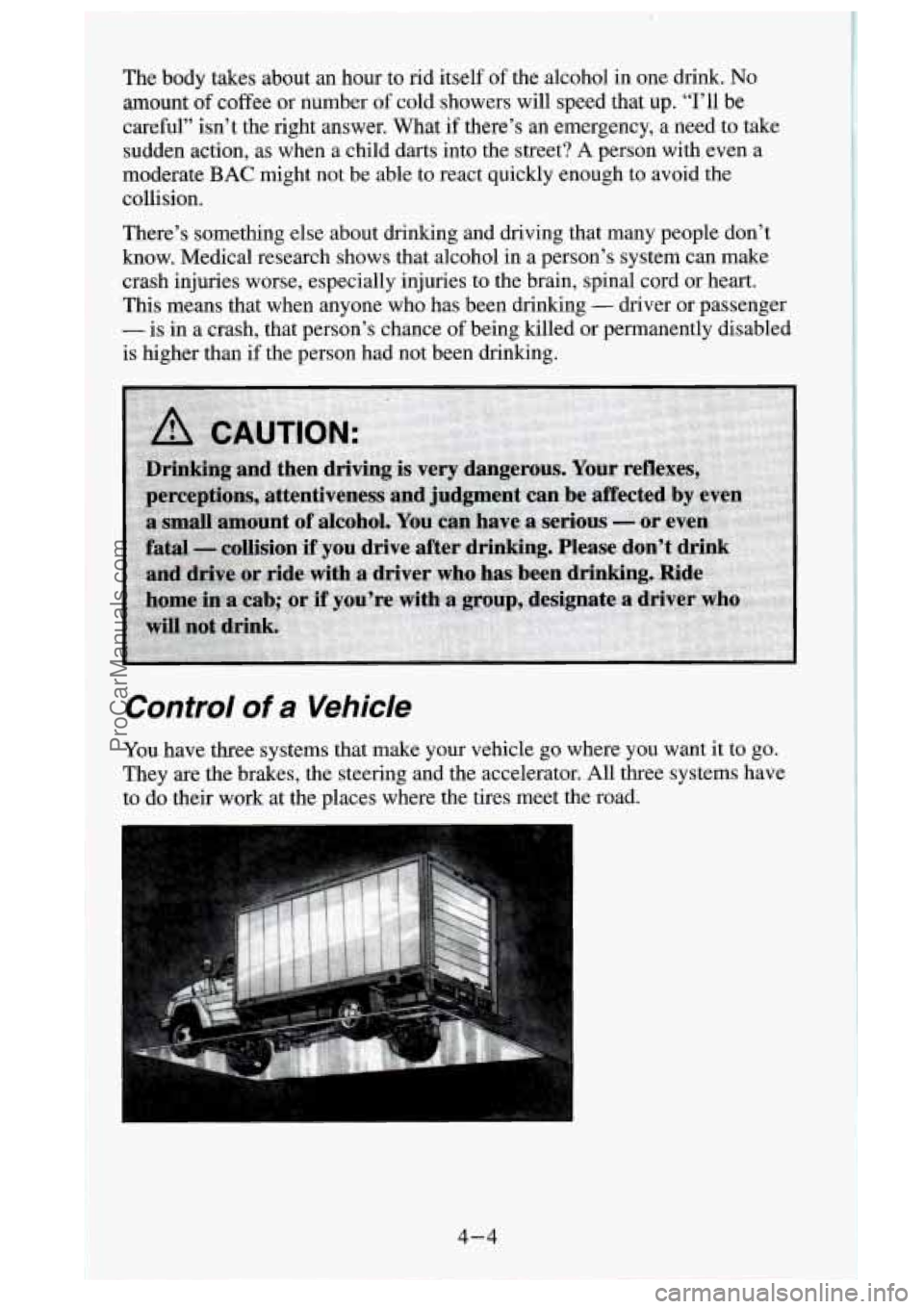
The body takes about an hour to rid itself of the alcohol in one drink. No
amount of coffee or number of cold showers will speed that up. “I’ll be
careful” isn’t
the right answer. What if there’s an emergency, a need to take
sudden action, as when a child darts into the street? A person with even a
moderate
BAC might not be able to react quickly enough to avoid the
collision.
There’s something else about drinking and driving that many people don’t
know. Medical research shows that alcohol in a person’s system can make
crash injuries worse, especially injuries to the brain, spinal cQrd or heart.
This means that when anyone who has been drinking
- driver or passenger
- is in a crash, that person’s chance of being killed or permanently disabled
is higher than if the person had not been drinking.
Control of a Vehicle
You have three systems that make your vehicle go where you want it to go.
They are the brakes, the steering and the accelerator. All three systems have
to do their work at the places where the tires meet the road.
4-4
ProCarManuals.com
Page 179 of 488

Sometimes, as when you’re driving on snow or ice, it’s easy to ask more of
those control systems than the tires and road can provide. That means you
can lose control of your vehicle.
Braking
Braking action involves perception tinze and reaction time.
First, you have to decide to push on the brake pedal. That’s perception time.
Then you have to bring up your foot and do it. That’s reaction time.
Average reuction tinze is about 3/4 of a second. But that’s only an average. It
might be less with one driver and as long as two or three seconds or more
with another. Age, physical condition, alertness, coordination, and eyesight
all play
a part. So do alcohol, drugs and frustration. But even in 3/4 of a
second, a vehicle moving at 60 mph (1 00 km/h) travels 66 feet (20 m). That
could be
a lot of distance in an emergency, so keeping enough space
between your vehicle and others is important.
And,
of course, actual stopping distances vary greatly with the surface of the
road (whether it’s pavement or gravel); the condition of the road (wet, dry,
icy); tire tread; and the condition
of your brakes.
Avoid needless heavy braking. Some people drive
in spurts - heavy
acceleration followed by heavy braking
- rather than keeping pace with
traffic. This is
a mistake. Your brakes may not have time to cool between
hard stops. Your brakes will wear out much faster if you do
a lot of heavy
braking. If you keep pace with
the traffic and allow realistic following
distances, you will eliminate
a lot of unnecessary braking. That means better
braking and longer brake life.
If your engine ever stops while you’re driving, brake normally but don’t
pump your brakes. If you do, the pedal may get harder to push down. If
your engine stops, you will still have
some power brake assist. But you will
use
it when you brake. Once the power assist is used up, it may take longer
to stop and the brake pedal will be harder to push.
4-5
ProCarManuals.com
Page 180 of 488
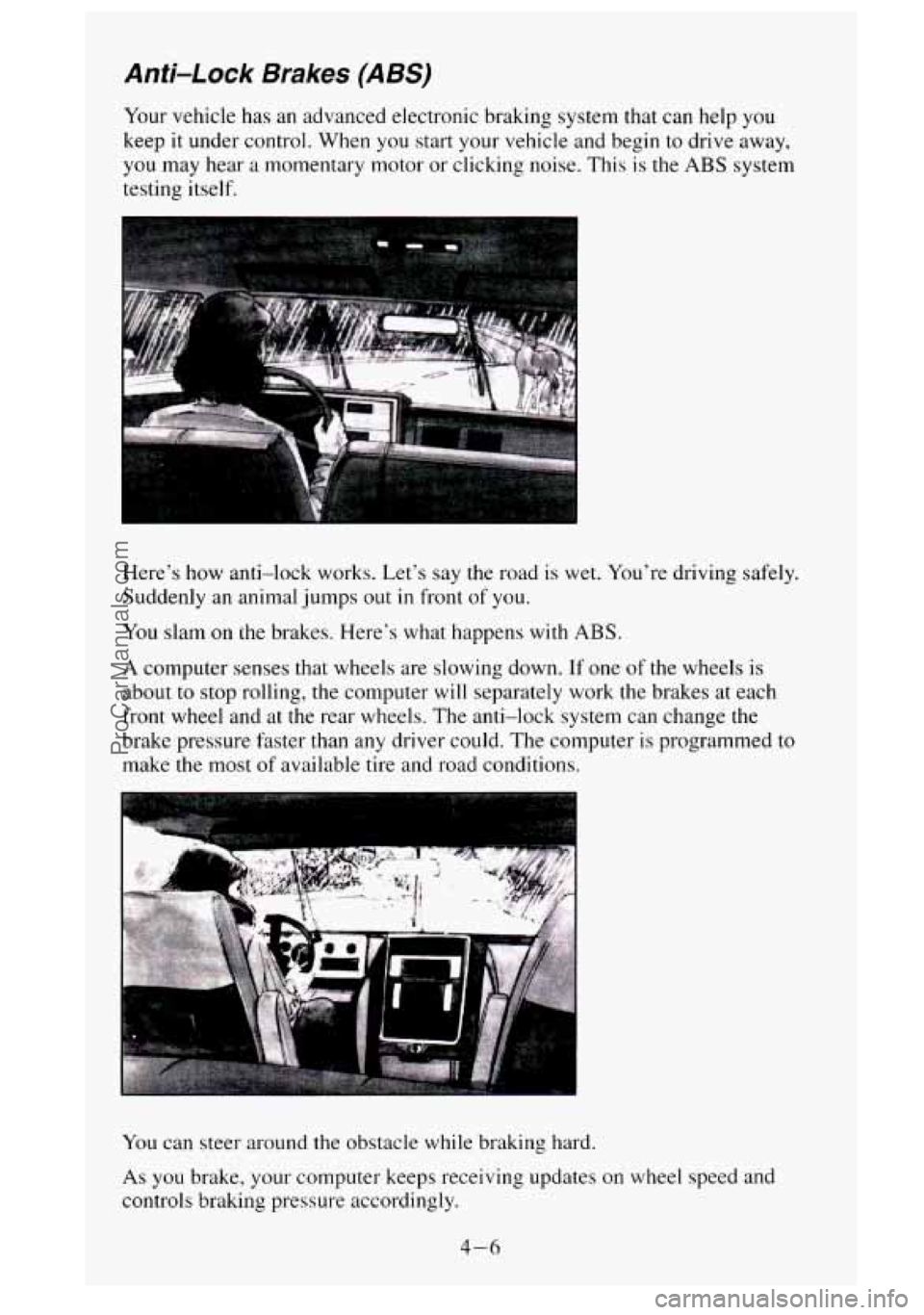
Anti-Lock Brakes (ABS)
Your vehicle has an advanced electronic braking system that can help you
keep it under control. When you start your vehicle and begin to drive away,
you may hear a momentary motor or clicking noise. This is the
ABS system
testing itself.
Here's how anti-lock works. Let's say the road is wet. You're driving safely.
Suddenly an animal jumps out
in front of you.
You slam on the brakes. Here's what happens with ABS.
A computer senses that wheels are slowing down. If one of the wheels is
about
to stop rolling, the computer will separately work the brakes at each
front wheel and at the rear wheels. The anti-lock system can change the
brake pressure faster than any driver could. The computer is programmed to
make the most
of available tire and road conditions.
You can steer around the obstacle while braking hard.
As you brake, your computer keeps receiving updates on wheel speed and
controls braking pressure accordingly.
4-6
ProCarManuals.com